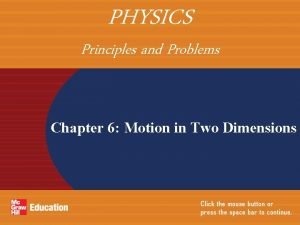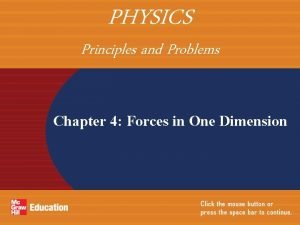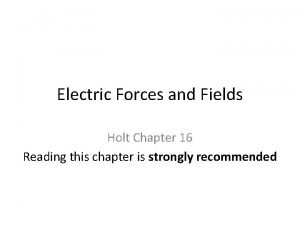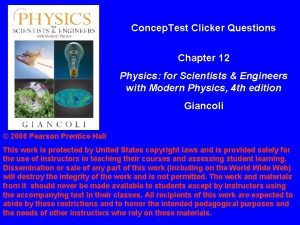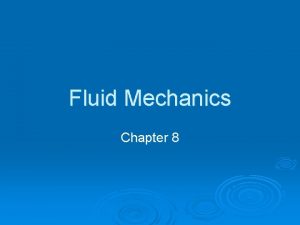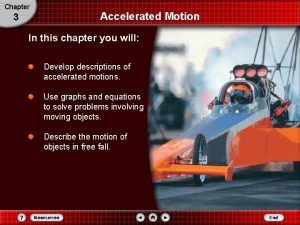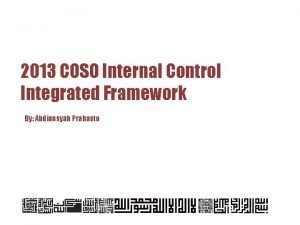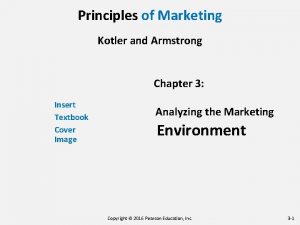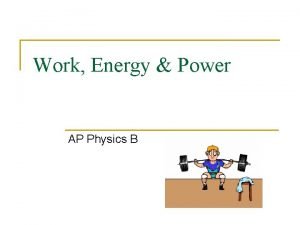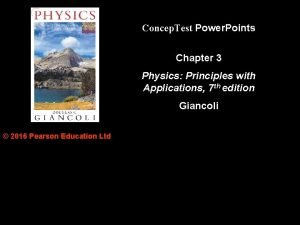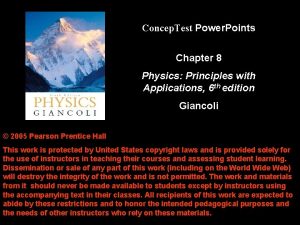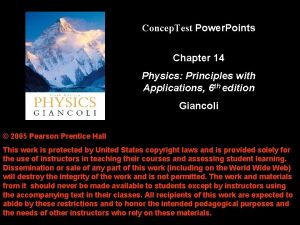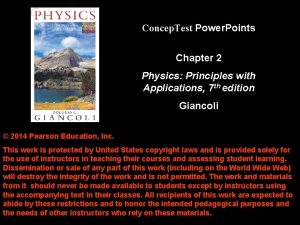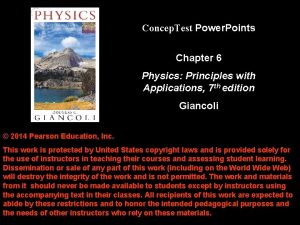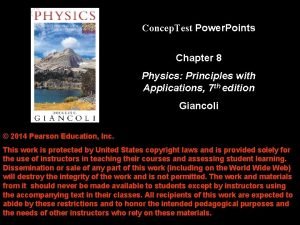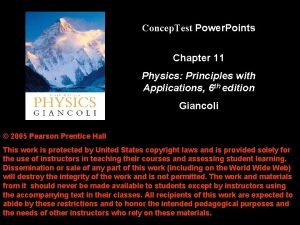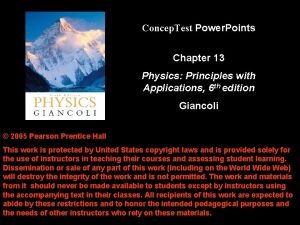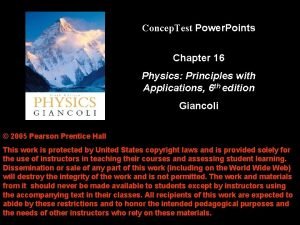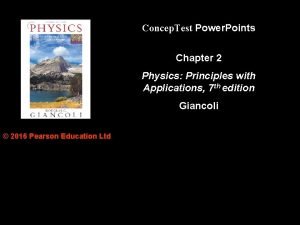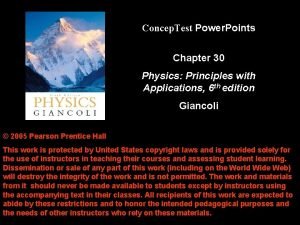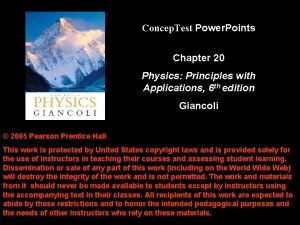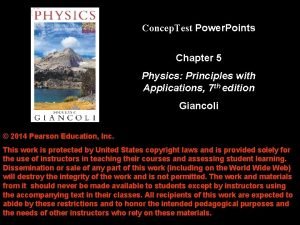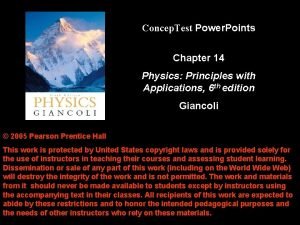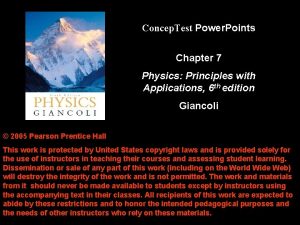Concep Test Power Points Chapter 17 Physics Principles


















- Slides: 18

Concep. Test Power. Points Chapter 17 Physics: Principles with Applications, 6 th edition Giancoli © 2005 Pearson Prentice Hall This work is protected by United States copyright laws and is provided solely for the use of instructors in teaching their courses and assessing student learning. Dissemination or sale of any part of this work (including on the World Wide Web) will destroy the integrity of the work and is not permitted. The work and materials from it should never be made available to students except by instructors using the accompanying text in their classes. All recipients of this work are expected to abide by these restrictions and to honor the intended pedagogical purposes and the needs of other instructors who rely on these materials.

Concep. Test 17. 1 a Electric Potential Energy I 1) proton 1) A proton and an electron are in a constant electric field created by oppositely charged plates. You release the proton from the positive side and the electron from the negative side. Which feels the larger electric force? 2) electron 3) both feel the same force 4) neither – there is no force 5) they feel the same magnitude force but opposite direction electron - + proton

Concep. Test 17. 1 b Electric Potential Energy II 2) A proton and an electron are in a constant electric field created by oppositely charged plates. You release the proton from the positive side and the electron from the negative side. Which has the larger acceleration? 1) proton 2) electron 3) both feel the same acceleration 4) neither – there is no acceleration 5) they feel the same magnitude acceleration but opposite direction electron - + proton

Concep. Test 17. 1 c Electric Potential Energy III 1) proton 3) A proton and an electron are in a constant electric field created by oppositely charged plates. You release the proton from the positive side and the electron from the negative side. When it strikes the opposite plate, which one has more KE? 2) electron 3) both acquire the same KE 4) neither – there is no change of KE 5) they both acquire the same KE but with opposite signs electron - + proton

Concep. Test 17. 2 Work and Potential Energy 4) Which group of charges took more work to bring together from a very large initial distance apart? +2 d +1 +1 d +1 Both took the same amount of work d d +1

Concep. Test 17. 3 a Electric Potential I 1) V > 0 5) What is the electric potential at point A? 2) V = 0 3) V < 0 A B

Concep. Test 17. 3 b Electric Potential II 1) V > 0 6) What is the electric potential at point B? 2) V = 0 3) V < 0 A B

Concep. Test 17. 4 Hollywood Square 7) Four point charges are arranged at the corners of a square. Find the electric field E and the potential V at the center of the square. 1) E = 0 V=0 2) E = 0 V 0 3) E 0 V 0 4) E 0 V=0 5) E = V regardless of the value -Q +Q

Concep. Test 17. 5 a Equipotential Surfaces I 1 8) At which point does V = 0? 5 all of them 2 +Q 3 4 –Q

Concep. Test 17. 5 b Equipotential Surfaces II 9) Which of these configurations gives V = 0 at all points on the x-axis? +2 m. C +1 m. C x -2 m. C -1 m. C 1) +2 m. C -2 m. C x -1 m. C 4) all of the above -2 m. C 2) x +1 m. C -1 m. C 3) 5) none of the above

Concep. Test 17. 5 c Equipotential Surfaces III 10) Which of these configurations gives V = 0 at all points on the y-axis? +2 m. C +1 m. C x -2 m. C -1 m. C 1) +2 m. C -2 m. C x -1 m. C 4) all of the above -2 m. C 2) x +1 m. C -1 m. C 3) 5) none of the above

Concep. Test 17. 6 Equipotential of Point Charge 1) A and C 11) Which two points have the same potential? 2) B and E 3) B and D 4) C and E 5) no pair A C B E Q D

Concep. Test 17. 7 a Work and Electric Potential I 1) P 1 12 ) Which requires the most work, to move a positive charge from P to points 1, 2, 3 or 4 ? All points are the same distance from P. 2) P 2 3) P 3 4) P 4 5) all require the same amount of work 3 2 1 P 4

Concep. Test 17. 7 b Work and Electric Potential II 1) P 1 13) Which requires zero work, to move a positive charge from P to points 1, 2, 3 or 4 ? All points are the same distance from P. 2) P 2 3) P 3 4) P 4 5) all require the same amount of work 3 2 1 P 4

Concep. Test 17. 8 Capacitors 14) Capacitor C 1 is connected 1) C 1 across a battery of 5 V. An identical capacitor C 2 is 2) C 2 connected across a battery of 10 3) both have the same charge V. Which one has the most 4) it depends on other factors charge? +Q –Q

Concep. Test 17. 9 a Varying Capacitance I 15)What must be done to a 1) increase the area of the plates capacitor in order to 2) decrease separation between the plates increase the amount of 3) decrease the area of the plates charge it can hold (for 4) either (1) or (2) a constant voltage)? 5) either (2) or (3) +Q –Q

Concep. Test 17. 9 b Varying Capacitance II 1) the voltage decreases 16) A parallel-plate capacitor initially has a voltage of 400 V 2) the voltage increases and stays connected to the 3) the charge decreases battery. If the plate spacing is now doubled, what happens? 4) the charge increases 5) both voltage and charge change +Q –Q

Concep. Test 17. 9 c Varying Capacitance III 17) A parallel-plate capacitor initially has a potential difference of 400 V and is then disconnected from the charging battery. If the plate spacing is now doubled (without changing Q), what is the new value of the voltage? +Q –Q 1) 100 V 2) 200 V 3) 400 V 4) 800 V 5) 1600 V
 Concept map tungkol sa pamilihan
Concept map tungkol sa pamilihan Ac power formula
Ac power formula Straddle positioning example
Straddle positioning example Points of parity and points of difference
Points of parity and points of difference Physics: principles and problems chapter 6 answers
Physics: principles and problems chapter 6 answers Chapter 4 assessment physics answers
Chapter 4 assessment physics answers Chapter 2 physics test prep representing motion
Chapter 2 physics test prep representing motion Holt physics chapter 16 test
Holt physics chapter 16 test Chapter 12 physics test
Chapter 12 physics test Chapter 8 fluid mechanics
Chapter 8 fluid mechanics Accelerated motion chapter 3 answers
Accelerated motion chapter 3 answers Coso internal control integrated framework 2013 pdf
Coso internal control integrated framework 2013 pdf Dunamis and exousia power
Dunamis and exousia power Modern physics vs classical physics
Modern physics vs classical physics University physics with modern physics fifteenth edition
University physics with modern physics fifteenth edition Physics ia topic ideas
Physics ia topic ideas Principle of marketing chapter 3
Principle of marketing chapter 3 Section 1 organisms and their relationships
Section 1 organisms and their relationships Physics work equations
Physics work equations




